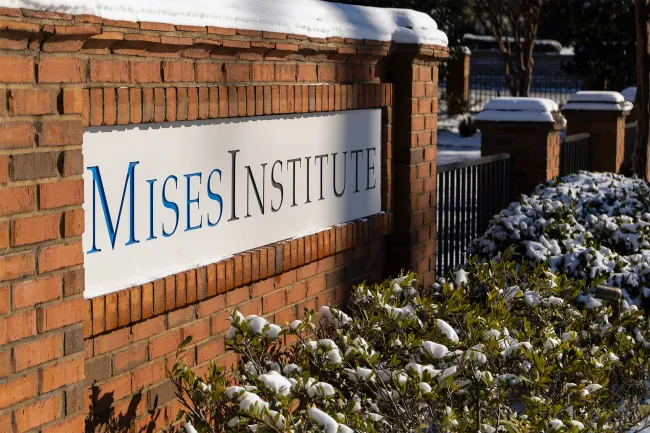Once again, rioters have taken to the streets of Los Angeles—this time to oppose President Donald Trump’s deportation efforts. What began as peaceful, constitutionally-protected demonstrations quickly turned “overwhelmingly peaceful”—or, in other words, into fiery, violent chaos: cars ablaze, local businesses ransacked—the whole nine yards.
Never fear, however: the Trump administration promptly deployed the National Guard and the US Marines to help local police suppress the mayhem—or, in other words, to do just enough to make the angry mobs even angrier: tear gas, rubber bullets, batons—not even close to the whole nine yards.
The purpose here is not to question the might of America’s armed forces. Rather, it is to bring to light the nature of the regime itself—and to explain how the interplay of constitutional rights, public property, optics, and the state’s monopoly-claim on security not only causes these riots in the first place but also prolongs them.
This is especially true given that it is precisely the US government themselves these actions are directed against. When the very regime being protested assumes responsibility for keeping their own protestors at bay—all while trying to preserve some semblance of favorable optics amongst them and the broader public—it should come as no surprise to anyone that chaos inevitably ensues. Regrettably, the regime we have falls far short of the one we need.
The State as Provocateur
Before we analyze the state’s actions and priorities when handling riots, we must first consider the causal mechanisms behind them in the first place. We must consider the initial motivations of the rioters: protesting state actions. It becomes readily apparent that the state is the target of nearly all protests—particularly those that turn violent.
The reason is obvious: the state becomes the natural target of protests and riots because their monopoly on violence is directed against the protesters’ interests. Whether it be instances of police brutality, immigration crackdowns, abortion laws—you name it—the perpetrator of all these initial interventions is the state.
Dissidents, feeling their constitutionally-protected right to assemble and vocalize their disagreements to be disappointingly lacking, oftentimes escalate their efforts well beyond the shield of the law. They recognize that their frustration—bottlenecked into public protest—is hardly enough to get the attention of political leaders—much less convince them to change their policies. So, naturally, they resort to nearly indiscriminate violence and looting. This assumes, of course, that violence isn’t first sparked by “opportunity-alert” hooligans with no real interest in political activism and a particular aptitude for ransacking local businesses.
On your way home from the night shift? Steer clear of the mob-occupied streets unless you wish to be ripped from your soon-to-be-torched car. Don’t attempt to drive around them, either—they might let you run them over, and the virtuous state might just stick you with a felony charge. The masked arsonists will probably get off scot-free, of course.
Now, should a legion of mall cops courageously take to the streets with two loaded magazines to suppress the riotous mob, the state would undoubtedly put a stop to it. They promise they’ll handle it—but they don’t.
The State as “Savior”
Most notably, the state’s response isn’t motivated by a desire to protect lives and property. Rather, it is shaped—and therefore constrained—by the need to manage public perception. The result? Soft-handed leniency toward the culprits, lest the authorities appear to trample anyone’s constitutional right to protest.
Even more ironically, it is frequently unimplicated parties—journalists via rubber bullet, for example—who seem to find themselves on the receiving end of the state’s “righteous justice.” This markedly backward approach only prolongs the violence, leading to even greater destruction of property. This is costly, not just in terms of property, but often in terms of lives.
This, of course, is not to advocate a heavy-handed response by the state per se. If they insist upon taking up the mantle of defending lives and property, doing so effectively is paramount. The point is: they don’t. Instead, they often only rile up the mobs—inciting and enabling further violence, sometimes quite openly and directly.
While the state plays both virus and cure, let us now consider the free-market alternative to this roundabout dilemma.
The Private Solution
In a free market—where property rights are respected—those who are unsatisfied with a firm’s goods or services can simply choose not to patronize that firm. If they are so appalled by their legitimate (i.e., respectful of property rights) actions that they do not believe the firm should stay in business, they are free to organize boycotts or even start their own competing business, so long as property rights are not violated.
It is important to reiterate: these uprisings are aimed at the state. In the absence of the state, the mantle of defense falls on individuals voluntary associations and, by extension, for-profit firms specializing in the defense of property rights.
A property rights social order would not only rid society of the primary target of nearly all cases of civil unrest—thereby reducing the likelihood that unrest occurs at all—but would also enable individual property owners, through their own means or via private security firms, to swiftly and justifiably vanquish violent mobs with a simple yet decisive litmus test: Have they violated my property rights? If yes, a property owner—or the firm he employs—would be both morally and legally vindicated in forcefully retaliating against the invasion.
In the unlikely event that a violent mob—absent the state and, therefore, absent government policies to protest—does take to the streets to ransack a business or drag people from their cars, we must recall: these streets would not be owned by “the public.” They would be owned by an individual (or, more precisely, by a few or many individuals). These individuals—whose property bounds are clearly established and delineated—would undoubtedly be well within their right to repel aggressors by whatever means necessary.
While taking on the mobs themselves would be perfectly justified under a libertarian social order (this fact alone renders riots unlikely), it is also plausible that this task would fall to the above-mentioned private defense firms—who exist on the market due to a demand for protection services.
Hans-Hermann Hoppe describes a system where individual property owners are protected by insurance agencies who specialize in the defense of property rights. Fees would be assessed based on the risk involved in taking on individual clients—as potential victims and as potential aggressors. Hoppe explains:
Most if not all aggressors, being bad risks, would be left without any insurance whatever… All aggressors would be specific individuals or groups, located at specific places and equipped with specific resources. In response to attacks on their clients, insurance agencies would specifically target these locations and resources for retaliation…
Most notably, this creates a powerful incentive against aggression, as committing such acts would effectively constitute forfeiting one’s own protection and, by extension, one’s good reputation amongst firms of all kinds (other insurance firms, their own employers, etc.) with whom they do business. The best-case scenario for those who insist on violent behavior would be ostracization from the bulk of society—far from the slap-on-the-wrist status quo. On the other hand: “[The insurance agencies] would want to avoid any collateral damage as they would otherwise become entangled with and liable to other insurers.”
Not only would this approach drastically reduce the likelihood of victimization by a vicious horde, but it would also ensure the accountability of those enforcing property rights who—unlike the state—are just as susceptible to profit and loss as any other firm on the market. Ultimately, it would be the firms who are best at keeping the peace that would thrive—while firms as reckless and ineffective (and in many cases, outright malevolent) as the state is today would quickly drown under the superior services offered by competitors.
I must reiterate: this hypothetical response to riots would largely be unnecessary in the first place under a libertarian social order. Without the catalyst of these uprisings—the state—and with a prevailing orientation toward respecting property rights, protests-turned-pandemonium would become a relic of a less civilized age. The state preserves disorder. The upholding of property rights is order.


